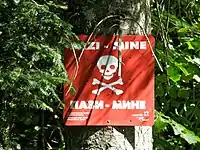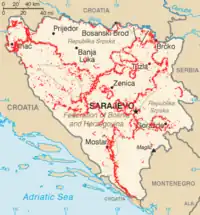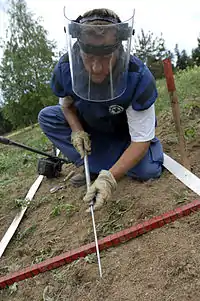Land mines in Bosnia and Herzegovina
Land mine contamination in Bosnia and Herzegovina is a serious aftereffect of the Bosnian War, which took place from 1992 until 1995. During this time period, all 3 conflicting factions (ARBiH, HVO, and VRS) planted land mines near the current-day political entity borders. As a result, the country has had the most severe land mine problems in the world. Although landmine removal efforts have made progress throughout the country and the landmine-related deaths have steadily decreased each year, many people are still killed or suffer injuries caused by unexploded munitions in Bosnia and Herzegovina. Despite the threat of landmines, people enter contaminated areas out of economic necessity.[1]

Land mine situation


Bosnia and Herzegovina's land mine contamination stems exclusively from the 1992–95 war in the country. Throughout the war, landmines were used by all three warring factions (ARBiH, HVO and VRS) and the location of the landmines is where the military confrontations lines were during the war period. The majority of landmines which were used by the three sides were the PROM-1, a Yugoslav manufactured anti-personnel mine which has since been banned by the Ottawa Treaty. Many landmines today also follow the IEBL dividing the two entities, which are the Federation of Bosnia and Herzegovina and Republika Srpska. By 1996, some two million land mines and unexploded munitions littered Bosnia.
In September 2013, land mines and unexploded munitions remained scattered in 28,699 locations. A total of 1,230.70 km2 (2.4% of the country's territory) was mined.[2] The next year, in May 2014, extensive landslides and the worst flooding since the 19th century unearthed landmines, prompting authorities to send in de-mining workers to locate and deactivate mines that were threatening residential areas which had already been deemed cleared.[3]
Land mine clearing is done by various government agencies and NGOs as well as some NATO military units. Between 1996 and 2017, more than 3,000 square kilometres have been cleared of mines. Bosnia and Herzegovina's strategic vision in 2008 was to clear all land mines by the year 2019. In April 2017, experts thought it would take at least five years longer, citing a lack of funds as the primary hurdle. 80,000 mines were estimated to be yet uncleared, located across 2.2% (1,125 km2) of the Bosnian territory.[4][5] In December 2017, the deadline was moved to 2025, but experts believe that this is an unreasonable goal based on the lack of financial resources. Some suggest that it could take several more decades.[6] According to the Bosnia and Herzegovina Mine Action Centre, the landmine contamination problem impacts over 538,000 people in over 1,400 communities (around 15% of the population).[1]
On 4 April, International Mine Awareness Day, the government, the UN and a number of other international and local NGOs inform citizens about the dangers of land mines and the efforts to clear them.[4]
In April 2019 on International Mine Awareness Day, a project called Mine Free Sarajevo was launched which envisioned a Sarajevo free of mines. The project was fully funded by the United States, which provided over $1.6 million in funding, making it the largest contribution in a decade dedicated to landmine clearance in Bosnia. Four municipalities in the Sarajevo region were cleared of mines: Stari Grad, East Stari Grad, Vogošća, and Novi Grad, clearing 6 million square meters of previously inaccessible land and returning it to local communities. The project utilised land release methodology, a cost-effective and safe way to release large areas by combining technical and non-technical methods. During the demining process in these municipalities, MDDC teams (Mine Detection Dog Center in Bosnia and Herzegovina) found and destroyed 841 explosive devices, out of which there were 445 mines and 396 unexploded ordnances.[7][8]
Mine Free Sarajevo officially closed on 1 September 2021 and the area is now completely mine-free and therefore significantly safer for locals and tourists. In addition, several crucial economic opportunities, such as further development of important agricultural land and infrastructure projects can resume.[7]
| Administrative level | 2019 | 2020 |
|---|---|---|
| Una-Sana Canton | 96.26 (37.17) | 95.08 (36.71) |
| Posavina | 15.53 (6.00) | 14.98 (5.78) |
| Tuzla | 80.16 (30.95) | 80.69 (31.15) |
| Zenica-Doboj | 112.69 (43.51) | 114.67 (44.27) |
| Bosnian-Podrinje | 46.82 (18.08) | 46.83 (18.08) |
| Central Bosnia | 113.10 (43.67) | 110.95 (42.84) |
| Herzegovina-Neretva | 149.87 (57.87) | 149.81 (57.84) |
| West Herzegovina | 0.82 (0.32) | 0.82 (0.32) |
| Sarajevo | 58.04 (22.41) | 58.06 (22.42) |
| Canton 10 | 79.27 (30.61) | 78.96 (30.49) |
| Federation of BiH | 752.56 (290.57) | 750.86 (289.91) |
| Brčko District | 13.11 (5.06) | 12.99 (5.02) |
| Republika Srpska | 199.59 (77.06) | 192.51 (74.33) |
| Total | 965.26 (372.69) | 956.36 (369.25) |
Land mine casualties
From 1992 through 2008, 5,005 people were killed or injured by land mines or unexploded munitions. Wartime casualties stood at 3,339 killed and injured. Peacetime casualties, from 1996 through 2008 number 1,666 of which 486 persons were fatalities. From 1996 to 2017, more than 1,750 people were injured, at least 612 of them fatalities.[4] According to the International Committee of the Red Cross, about 15% of all landmine victims are children.[6]
| Land mine casualties in Bosnia and Herzegovina 1996-2011 | |||
|---|---|---|---|
| Year | Killed | Injured | Total |
| 1996 | 110 | 552 | 662 |
| 1997 | 88 | 202 | 290 |
| 1998 | 60 | 80 | 149 |
| 1999 | 38 | 57 | 95 |
| 2000 | 35 | 65 | 100 |
| 2001 | 32 | 55 | 87 |
| 2002 | 26 | 46 | 72 |
| 2003 | 23 | 31 | 54 |
| 2004 | 16 | 27 | 43 |
| 2005 | 10 | 9 | 19 |
| 2006 | 18 | 17 | 35 |
| 2007 | 8 | 22 | 30 |
| 2008 | 19 | 20 | 39 |
| 2009 | 9 | 19 | 28 |
| 2010 | 6 | 8 | 14 |
| 2011[11] | 9 | 13 | 22 |
| Totals | 507 | 1,223 | 1,739 |
References
- "Bosnia and Herzegovina | MAG". www.maginternational.org. Retrieved 2023-07-16.
- "Bosnia and Herzegovina mine situation September 2013". BH MAC. July 2014. Archived from the original on 15 February 2015. Retrieved 12 July 2014.
- "Landmines unearthed by shifting mud in flooded Balkans". Big News Network. Retrieved 19 May 2014.
- Igor Spaic (4 April 2017). "Bosnia 'Failing to Meet Landmine Removal Target'". Balkan Insight. Retrieved 22 November 2018.
- Matthew Clayfield (14 October 2017). "Bosnia and Herzegovina may never be clear of landmines". Australian Broadcasting Corporation. Retrieved 22 November 2018.
- "Living with landmines in Bosnia and Herzegovina". 2017-12-04.
{{cite journal}}: Cite journal requires|journal=(help) - "After 20 Years, The City of Sarajevo is Mine-Free | News | ITF Enhancing Human Security". www.itf.si. 2021-09-22. Retrieved 2023-07-19.
- "Mine Free Sarajevo Field Operations Completed | News | ITF Enhancing Human Security". www.itf.si. 2021-06-30. Retrieved 2023-07-19.
- "Izvještaj o protuminskom djelovanju za 2019. godinu" [Report on mine action for 2019] (PDF). BHMAC (in Bosnian). Centar za uklanjanje mina u Bosni i Hercegovini. Retrieved 17 September 2022.
- "Izvještaj o protivminskom djelovanju za 2020. godinu" [Report on mine action for 2020] (PDF). BHMAC (in Bosnian). Centar za uklanjanje mina u Bosni i Hercegovini. Retrieved 17 September 2022.
- "Casualties Overview". The Monitor. 21 September 2012. Retrieved 11 February 2014.
External links
- Bosnia and Herzegovina Mine Action Centre(in Bosnian, English, Serbian, and Croatian)